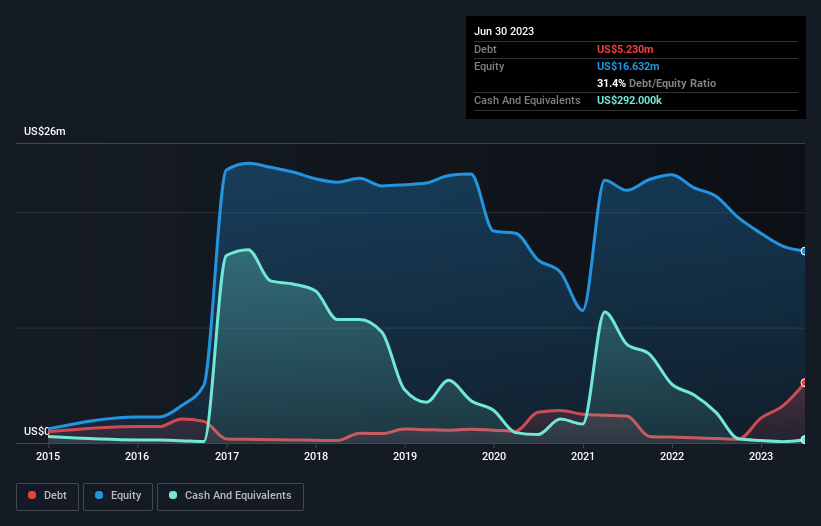
Some say volatility, rather than debt, is the best way to think about risk as an investor, but Warren Buffett famously said that 'Volatility is far from synonymous with risk.' So it might be obvious that you need to consider debt, when you think about how risky any given stock is, because too much debt can sink a company. As with many other companies Polar Power, Inc. (NASDAQ:POLA) makes use of debt. But the real question is whether this debt is making the company risky.
When Is Debt Dangerous?
Debt assists a business until the business has trouble paying it off, either with new capital or with free cash flow. Ultimately, if the company can't fulfill its legal obligations to repay debt, shareholders could walk away with nothing. While that is not too common, we often do see indebted companies permanently diluting shareholders because lenders force them to raise capital at a distressed price. Of course, debt can be an important tool in businesses, particularly capital heavy businesses. When we think about a company's use of debt, we first look at cash and debt together.
View our latest analysis for Polar Power
What Is Polar Power's Debt?
You can click the graphic below for the historical numbers, but it shows that as of June 2023 Polar Power had US$5.23m of debt, an increase on US$391.0k, over one year. However, it does have US$292.0k in cash offsetting this, leading to net debt of about US$4.94m.

A Look At Polar Power's Liabilities
We can see from the most recent balance sheet that Polar Power had liabilities of US$10.1m falling due within a year, and liabilities of US$1.54m due beyond that. On the other hand, it had cash of US$292.0k and US$6.51m worth of receivables due within a year. So it has liabilities totalling US$4.88m more than its cash and near-term receivables, combined.
This deficit isn't so bad because Polar Power is worth US$17.4m, and thus could probably raise enough capital to shore up its balance sheet, if the need arose. However, it is still worthwhile taking a close look at its ability to pay off debt. The balance sheet is clearly the area to focus on when you are analysing debt. But you can't view debt in total isolation; since Polar Power will need earnings to service that debt. So when considering debt, it's definitely worth looking at the earnings trend. Click here for an interactive snapshot.
Over 12 months, Polar Power reported revenue of US$18m, which is a gain of 6.6%, although it did not report any earnings before interest and tax. That rate of growth is a bit slow for our taste, but it takes all types to make a world.
Caveat Emptor
Importantly, Polar Power had an earnings before interest and tax (EBIT) loss over the last year. Its EBIT loss was a whopping US$5.0m. When we look at that and recall the liabilities on its balance sheet, relative to cash, it seems unwise to us for the company to have any debt. Quite frankly we think the balance sheet is far from match-fit, although it could be improved with time. However, it doesn't help that it burned through US$7.2m of cash over the last year. So suffice it to say we consider the stock very risky. When analysing debt levels, the balance sheet is the obvious place to start. However, not all investment risk resides within the balance sheet - far from it. For example, we've discovered 3 warning signs for Polar Power (2 are significant!) that you should be aware of before investing here.
At the end of the day, it's often better to focus on companies that are free from net debt. You can access our special list of such companies (all with a track record of profit growth). It's free.
New: Manage All Your Stock Portfolios in One Place
We've created the ultimate portfolio companion for stock investors, and it's free.
• Connect an unlimited number of Portfolios and see your total in one currency
• Be alerted to new Warning Signs or Risks via email or mobile
• Track the Fair Value of your stocks
Have feedback on this article? Concerned about the content? Get in touch with us directly. Alternatively, email editorial-team (at) simplywallst.com.
This article by Simply Wall St is general in nature. We provide commentary based on historical data and analyst forecasts only using an unbiased methodology and our articles are not intended to be financial advice. It does not constitute a recommendation to buy or sell any stock, and does not take account of your objectives, or your financial situation. We aim to bring you long-term focused analysis driven by fundamental data. Note that our analysis may not factor in the latest price-sensitive company announcements or qualitative material. Simply Wall St has no position in any stocks mentioned.
About NasdaqCM:POLA
Polar Power
Designs, manufactures, and sells direct current (DC) power generators, renewable energy, and cooling systems in the United States, Canada, Australia, the South Pacific Islands, Asia, Europe, the Middle East, the United Kingdom, and South Africa.
Low and slightly overvalued.
Similar Companies
Market Insights
Community Narratives



